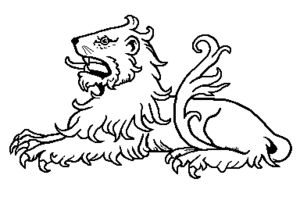Lion: Difference between revisions
From Cunnan
Jump to navigationJump to search
(initial doc) |
|||
| (6 intermediate revisions by 4 users not shown) | |||
| Line 1: | Line 1: | ||
[[image:Lion_Couchant.png|thumb|right|A lion [[couchant]]]] |
|||
A large [[carnivorous]] [[feline]] [[mammal]] (Panthera leo) of [[Africa]] and northwest India, having a short [[tawny]] coat, a tufted tail, and, in the male, a heavy mane around the neck and shoulders. |
|||
The '''lion''' is a large feline [[animal]], native to [[Africa]]. |
|||
==Heraldic Lions== |
|||
The '''lion''' is a common [[heraldry|heraldic]] [[charge]]. It is often associated with the [[royal]] [[arms]] of [[England]]. An English lion is ''lion [[passant]] [[gardant]]''. However it can be confused with a [[leopard]] that was never used in heraldry with spots. |
|||
==People Associated with Lions== |
|||
The '''lion''' is used as the [[Christian]] [[12th century symbolism|symbol]] for Mark, one of the four Evangelists. For this reason, it often appears in [[church]] [[manuscript]]s in the [[illumination]]. |
|||
[[Richard I]]'s ferocious military prowess earned him the epithet ''Coeur de Lion'' (Lion Heart). |
|||
==See also== |
|||
*[[Lion (Maplet)|Lion according to Maplet's ''A Greene Forest'']] |
|||
[[category:device heraldry]] |
|||
Latest revision as of 16:42, 22 August 2008

A lion couchant
The lion is a large feline animal, native to Africa.
Heraldic Lions
The lion is a common heraldic charge. It is often associated with the royal arms of England. An English lion is lion passant gardant. However it can be confused with a leopard that was never used in heraldry with spots.
People Associated with Lions
The lion is used as the Christian symbol for Mark, one of the four Evangelists. For this reason, it often appears in church manuscripts in the illumination.
Richard I's ferocious military prowess earned him the epithet Coeur de Lion (Lion Heart).